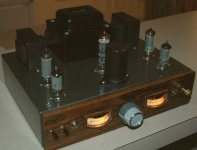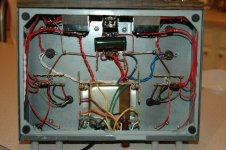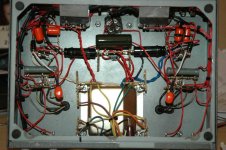Yes Graeme,
I know what you mean; it has been said to me that G.E.C. were not unknown for being a little "economical with the actualité "!
And it is not unusual to see makers' curves extending to absurd voltages and currents!
I used to have quite a lot of CV2179s and 4062s. At that time too, I had an AVO 163 valve tester and they all tested very well.
As I said before, as triodes they make excellent drivers for large valves; for a while I drove a pair of triode-strapped 813s with them, whilst at the same time using another as a line-stage.
Versatile!
7N7
I know what you mean; it has been said to me that G.E.C. were not unknown for being a little "economical with the actualité "!
And it is not unusual to see makers' curves extending to absurd voltages and currents!
I used to have quite a lot of CV2179s and 4062s. At that time too, I had an AVO 163 valve tester and they all tested very well.
As I said before, as triodes they make excellent drivers for large valves; for a while I drove a pair of triode-strapped 813s with them, whilst at the same time using another as a line-stage.
Versatile!
An externally hosted image should be here but it was not working when we last tested it.
7N7
Ciscokid said:Very nice! I still have my meters. How do/did you plan on hooking them into the circuit? Any shots of the underside?
Regards,
Danny
Here's one with the tubes and panel lit up and one of the underside. Not completely wired, but got the filaments and pilot lights and most of the wiring from the secondaries of the output transformers to the terminals.
Attachments
Ohhh.. All that room 🙂
Also, I noticed that you are using the original POT. I did the same thing at first but found the unit to be defective. I tried cleaning and that helped some but the sound would degrade after a little bit of use so I replaced with a 100k from my parts box and sound really opened up.
ck
Also, I noticed that you are using the original POT. I did the same thing at first but found the unit to be defective. I tried cleaning and that helped some but the sound would degrade after a little bit of use so I replaced with a 100k from my parts box and sound really opened up.
ck
3A5... Shhh......
Now don't go and let the secret out! Yes, the 3A5 is an incredible sounding dual-triode... but if everyone figures that out the prices will $$$!
The best sounding amp I've ever built was based on a pair of JAN 3A5 triodes in parallel. Better have some pretty seriously efficient speakers though. 🙂
Now don't go and let the secret out! Yes, the 3A5 is an incredible sounding dual-triode... but if everyone figures that out the prices will $$$!
The best sounding amp I've ever built was based on a pair of JAN 3A5 triodes in parallel. Better have some pretty seriously efficient speakers though. 🙂
Eusebius said:I'll recommend the 3A5 - cheapest good sounding DHT, and a double at that. I bought 100 really cheap - they're slightly bright but very detailed and have that genuine DHT sound. You need a good filament supply as always with DHTs. I use them in diff pairs to reduce mcrophonics, and put a couple of cheap plumbers rubber rings on each. Definitely one to try out for peanuts, since the really good DHTs are getting scarce and going up in price.
Plug-in replacement tubes for the 6CB6 in Pete Millett's 50 Watt Monoblock and Engineer's Amp:
8136 pentode
6EW6 high gm pentode
5JK6 high gm pentode, frame grid, (6JK6 is $$$) (and watch out for 6JL6 which is semi remote cutoff)
however this tube has knee hysteresis problems at higher currents, which are fixable with +20V on grid3
(note the 6JC6 9 pin is better and is on the $1 list)
8136 pentode
6EW6 high gm pentode
5JK6 high gm pentode, frame grid, (6JK6 is $$$) (and watch out for 6JL6 which is semi remote cutoff)
however this tube has knee hysteresis problems at higher currents, which are fixable with +20V on grid3
(note the 6JC6 9 pin is better and is on the $1 list)
Last edited:
I've been using 7-pin tubes for audio in a lot of projects lately. From single-ended 6AQ5s and 60FX5s to push-pull 32ET5s to single ended 3Q4s.
Very nice to see the little guys get a bit of love!
Very nice to see the little guys get a bit of love!
About battery tubes: Did one ever try the 3A4/DL93, which appears to be the big block among them?
Best regards!
Best regards!
I have a pair of 3A4s but haven't personally tried them yet. They sure fetch a hefty premium over the 3Q4 or 3V4!
It isn't an AF tube per-se but I have a sleeve of 3B4s that I plan on trying over the winter time. It's got some potential as a potent miniature DHP if it can be tamed. A pair of 3B4s driven by a 3A5 input tube could make for a neat little directly heated amp.
It isn't an AF tube per-se but I have a sleeve of 3B4s that I plan on trying over the winter time. It's got some potential as a potent miniature DHP if it can be tamed. A pair of 3B4s driven by a 3A5 input tube could make for a neat little directly heated amp.
Last edited:
Reviving this old thread. I'm doing a build using Pete Millett's driver board (triode into pentode LTP) and he's using 6J4 for the first tube.
I have little experience with 7-pin triodes. Is 6J4 my best bet, what are my other choices? I can build a pinout converter if need be, but I'd like to stay with a 7-pin triode.
I have little experience with 7-pin triodes. Is 6J4 my best bet, what are my other choices? I can build a pinout converter if need be, but I'd like to stay with a 7-pin triode.
6AU6 is an equivalent to the Russian 6ж4п (6Ж4П)
6AU6 is a pentode, are you talking about running it in triode mode?
Nooooo 😕 .....
I just noticed how confusing everything is when tubes are named this or that way.
6J4 would hint a Chinese tube, equivalent to the Russian tube 6Ж4П - as the letter Ж often is transcribed as J.
6Ж4П is an equivalkent to 6AU6 and I thought instinctively that it was an equivalent to 6J4, which is wasn't. (Btw 6AU6/6Ж4П is supposed to be a decent tube).
A quick search gives you a variety of tubes similar to 6J4:
I just noticed how confusing everything is when tubes are named this or that way.
6J4 would hint a Chinese tube, equivalent to the Russian tube 6Ж4П - as the letter Ж often is transcribed as J.
6Ж4П is an equivalkent to 6AU6 and I thought instinctively that it was an equivalent to 6J4, which is wasn't. (Btw 6AU6/6Ж4П is supposed to be a decent tube).
A quick search gives you a variety of tubes similar to 6J4:
6J4 = 6С2П = A2209
Similar Tubes
Other shape (e.g. bulb type):
6J4S
Normally replaceable-slightly different:
8532 ; 8532W ; CV1763
Other class quality (otherwise equal):
6J4W ; 6J4WA ; 6J4WB ; CV5311 ; M8248
Of course it is, as is also it's European EF94 equivalent. A very versatile small pentode.Btw 6AU6/6Ж4П is supposed to be a decent tube
Best regards!
Here in the US a 6J4 is a 7 pin high Gm triode that does very good for audio amp duty. I have a bunch of them. Back when I was developing the original TSE amp design I went through about 100 different tubes to find the best driver tube choice for a single stage driver that feeds a 45, 2A3 or 300B tube. I settled on the 5842, but the 6J4 was in the top ten list. It might have been further up the list if decent 7 pin PC board sockets were available in 2003.
The 6J4 was used in some military applications, so there are high spec versions available. The 6J4WA and the 8532 are the mil spec versions.
I have a pair of the Pete Millett driver boards, and used them for a year or two for testing. There is no reason to try other tubes. The 6J4's went into my boards, and is still in there. Unfortunately a dumm blonde accident fried both boards several years ago, so they went into the box of dead circuits and never came out.
No problem with the board design, but putting the banana plug into the power supply upside down does tend to let the smoke out of a lot of parts.
The 6AU6 is a 7 pin pentode intended for RF and IF amplifiers in AM radios. It is a miniaturized version of the 6SJ7. The 12AU6 was the IF amp tube in the AA5 table radio of the 50's. The 18FW6 is the 100 mA heater version from the "last gasp" version of the AA5 before silicon killed tube radios. They all make a decent audio tube though some can be quite microphonic at high gains. I'm running an 18FW6 in a 4 watt high gain series string guitar amp. The amp head must not sit on top of the speaker when the knobs are all set on 10.
The 6J4 was used in some military applications, so there are high spec versions available. The 6J4WA and the 8532 are the mil spec versions.
I have a pair of the Pete Millett driver boards, and used them for a year or two for testing. There is no reason to try other tubes. The 6J4's went into my boards, and is still in there. Unfortunately a dumm blonde accident fried both boards several years ago, so they went into the box of dead circuits and never came out.
No problem with the board design, but putting the banana plug into the power supply upside down does tend to let the smoke out of a lot of parts.
The 6AU6 is a 7 pin pentode intended for RF and IF amplifiers in AM radios. It is a miniaturized version of the 6SJ7. The 12AU6 was the IF amp tube in the AA5 table radio of the 50's. The 18FW6 is the 100 mA heater version from the "last gasp" version of the AA5 before silicon killed tube radios. They all make a decent audio tube though some can be quite microphonic at high gains. I'm running an 18FW6 in a 4 watt high gain series string guitar amp. The amp head must not sit on top of the speaker when the knobs are all set on 10.
... I settled on the 5842, but the 6J4 was in the top ten list...
Thanks George. What were some of the others on that list? If it's not a secret...🙂
I have an old Pioneer amp, SMR-150, that uses 6AR5 for the output tubes. They are 7 pin versions of 6K6G, good for 3.5W SE.
My local auction site has some temptingly priced EC903, that look to be interesting with their gold pins. They are a triode with a 2W dissipatation, mu 15.
My local auction site has some temptingly priced EC903, that look to be interesting with their gold pins. They are a triode with a 2W dissipatation, mu 15.
- Home
- Amplifiers
- Tubes / Valves
- 7-pin miniature tubes for audio?



